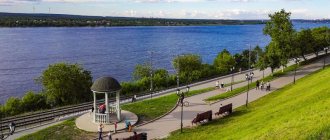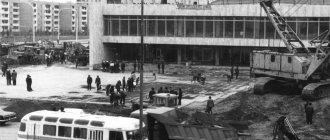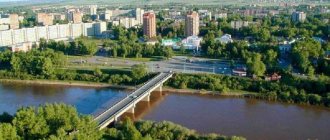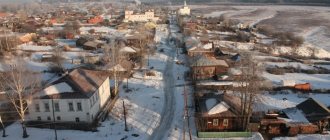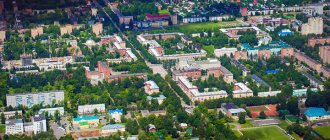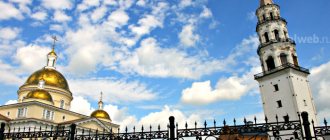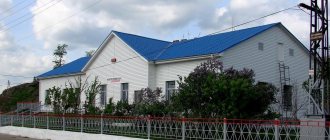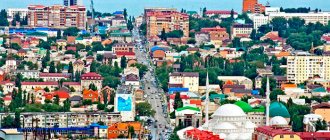Color photographs of Perm. Gallery 1.
House of the Mining Chief of the Perm Cannon Factories. Source: pastvu.com View of the city from the Kama. Source: pastvu.com House of the Mining Chief of the Perm Cannon Factories. Source: pastvu.com Outpost on Sibirskaya Street. Source: pastvu.com Black market, shopping arcades. Source: pastvu.com Cannon factory in Motovilikha. Source: pastvu.com
Elias Chapel and Torgovaya Street, 1900-1917. Source: pastvu.com Cathedral. Source: pastvu.com Black market, shopping arcades. Source: pastvu.com Steamboat at the pier on the Kama. Source: pastvu.com Sibirskaya street. Source: pastvu.com Street 1905 (in those days it was called Bolshaya). Source: pastvu.com
Top 5 “dead cities” of KUB (Perm region). Photo report PRM.ru
When decorating places of leisure and recreation everywhere in KUB, local residents prefer the brightest, coolest colors possible.
And here is the main attraction of these places? waste heaps. Coal dumps, rising several meters, are visible from afar. For many years, no one has been involved in reclamation of the rock. Rain streams wash away harmful substances from the dumps, which then end up in local water bodies.
Only sleepers remained from the mine narrow-gauge railways. The local population sold the rails for scrap metal long ago.
An acid-colored liquid flows to the surface from the depths of flooded mines. This is a real environmental disaster zone. According to environmentalists, the concentration of harmful substances in the Kosva, Bolshaya Gremyachaya, Kizel and other rivers exceeds the maximum permissible by thousands of times. The annual damage caused to the environment is estimated at 1 billion 800 million rubles. No one has calculated the damage caused to the territory of the KUB as a result of the theft of funds allocated in previous years to solve the socio-economic problems of the mining villages.
Neighborhoods of Kizel
There are also many mines scattered around the city of Kizel. This is one of them, the Klyuchevskaya mine. In better times, 750 thousand tons of coal were mined here per year.
In 1997, all mining operations at the mine ceased. Trees now grow in the industrial building where people recently worked.
To permanently close city-forming enterprises, serious reasons were required, and officials found them. Due to the difficult mining and geological conditions of deposit development, the low quality of Kizelovsky coal and its high cost, as it was said then, the coal mining industry in the Perm region ceased to exist.
Continuation of the photo strip dedicated to Kospashi and the abandoned mine near Kizel here
Afterword
In 2012, a ministry for the development of the territories of the former Kizelovsky coal basin was created in the Perm region. His main goal? to bring settlements out of a depressed state, and also to check the receipt and expenditure of funds from the federal center for the implementation of local development programs and employment for cities and towns. How effectively the ministry itself will work will become clear in the near future. Only for the resettlement of citizens from dilapidated housing in the KUB areas, the draft federal budget for 2013-2015 provides 230 million rubles. Whether these funds will reach the recipient is a big question.
Gallery 2
Black market. Source: pastvu.com Perm zemstvo. Source: pastvu.com
Sibirskaya street. Source: pastvu.com Theological Seminary. Source: pastvu.com Slobodka. Somewhere in Perm. Source: pastvu.com Embankment of the Kama River. Source: pastvu.com
Chocolate factory and bakery of A.F. Ezhov. Source: pastvu.com Spaso-Preobrazhensky Cathedral. Source: pastvu.com Buildings on Permskaya Street. Source: pastvu.com Mariinsk Women's Gymnasium. Source: pastvu.com Perm provincial prison. Source: pastvu.com
Panorama from Gorki. Source: pastvu.com Kirch. Now St. Mary's Evangelical Lutheran Church. Source: pastvu.com Zaimka station. Now here is Perm 2 station. Source: pastvu.com Railway bridge over the Danilikha River. Source: pastvu.com Railway line near Meshkov’s house. Source: pastvu.com
Abandoned cities of the Perm region
In the Perm region you can find several abandoned cities that were actively forming in the early 20th century around the coal mines that are ubiquitous in the region.
By the second half of the century, the deposits were drying up and people left their homes in search of new work.
This is how almost all abandoned settlements in the region appeared.
Nowadays, numerous abandoned buildings are of great interest not only to stalkers, but also to looters who are in an eternal search for profit.
Old Gubakha
The development of the territory of the future town began in the 18th century after the Perm region became subordinate to the Russian state. Large reserves of ore were discovered in the region, which became a decisive factor in the formation of the settlement. The mineral began to be actively mined and transported along the river. After 50 years, a geological expedition found coal reserves, after which a new era began in the development of Staraya Gubakha.
The village grew, a railway opened, along which the transportation of ore and coal became even more active. At the beginning of the 20th century, schools, hospitals and other infrastructure began to appear. Then the chemical industry began to develop here. The town became a real industrial center. By the middle of the last century, ecologists began to actively study the area and it turned out that the situation in the region was greatly deteriorating, which had a negative impact on the residents of Gubakha.
The soil and air were polluted, dust with harmful substances settled on the roofs and walls of houses. As a result, it was decided to move the entire city to a more favorable location, and in the seventies the outflow of local residents began. All enterprises were also closed and moved to a new location. The last production completed its work in the nineties.
Abandoned city Ugleuralsky
The city in the north of the Perm region was formed at the beginning of the 20th century after the discovery of a coal deposit on its territory, for which the region was famous. Several mines formed an entire settlement around them for workers to live.
Ugleuralsky played a significant role during the Second World War, taking wounded soldiers to his hospitals and continuing the extraction of coal, which was used to maintain the country’s military power. For faster transportation of products, a direct railway line was built between Ugleuralsk and Perm. By the sixties, fossil reserves had been exhausted and the town was quickly liquidated, transporting the population to other industrial centers.
Kizel
An abandoned city in the Perm region consists of dozens of abandoned buildings. A large outflow of local residents began in the second half of the last century after the reserves of the deposits located here were exhausted. When moving, people left all their utensils behind, which significantly increases the value of Kizel among stalkers. Now the facility is completely open to the public; no security measures have been observed. Almost every day on its territory you can meet marginalized people dismantling buildings for building materials.
Gallery 3
Kama embankment. Source: pastvu.com
Pryanishnikov's house. Source: pastvu.com Bedroom in a religious school. Source: pastvu.com Unloading watermelons on the embankment. Source: pastvu.com Lecture at theological school. Source: pastvu.com
Men's gymnasium. Source: pastvu.com House of Eremeev (Kamchatov). Source: pastvu.com Sibirskaya street. Source: pastvu.com Church in the name of All Saints. Source: pastvu.com Black market, Chapel of the Holy Prophet Elijah. Source: pastvu.com
Inside the religious school. Source: pastvu.com Nikolai Slavyanov and workers at cannon factories. Source: pastvu.com
Gallery 4
Old hospital in Motovilikha. Source: pastvu.com
Black market. Source: pastvu.com
In the garden of the house of the merchant A. S. Alina. on Sibirskaya 19. Source: pastvu.com Bacteriological Institute. Source: pastvu.com Pond in Staraya Slobodka. Source: pastvu.com
“Establishment of fruit, berry and sparkling waters of the heirs of A.F. Cherdyntsev” on Monastyrskaya Street. Source: pastvu.com Provincial Zemstvo Hospital. Source: pastvu.com Tribunes at the velodrome, now this site is Yunost Stadium. Source: pastvu.com Mount Vyshka, early 20th century. Source: pastvu.com Railway workshops in the area of the Peter and Paul Cathedral. Source: pastvu.com Pier on the Kama. Source: pastvu.com Copper smelter near Motovilikha pond. Source: pastvu.com
Abandoned churches of the Perm region
Despite the fact that the region is one of the large industrial centers of the Western Urals, quite religious people have long lived on its territory, which led to the emergence of a large number of churches in the 18-19 centuries, many of which were abolished after the Bolsheviks came to power, promoting atheism and completely abandoned the state religion.
Some of the abandoned temples have never been restored, despite the fact that some of them are architectural monuments of regional significance.
Church of the Nativity in the village of Iskor
The temple was built at the end of the 18th century, and in the 19th they began to actively expand it, subsequently adding beautiful paintings in the interior, which were worked on by a famous church artist, whose works have been preserved in many Ural churches. After the formation of the Soviet Union, the Church of the Nativity of Christ was closed and then completely looted. Throughout the entire period of the USSR, the building stood abandoned until local residents decided to restore it in the late nineties. The work required significant funds, which in the end were not enough and the temple was abandoned again.
Church of the Presentation of the Blessed Virgin Mary in the village of Kamgort
The majestic temple in the Gothic style was built at the beginning of the 19th century to replace an old wooden building that had fallen into disrepair. The Church of the Presentation of the Blessed Virgin Mary managed to work for about 15 years, after which it was closed by order of the Soviet government. During the years of the Union it was used to store grain, then it was abandoned until perestroika. After the collapse of the USSR, the temple was partially restored, but for unknown reasons they did not put it back into operation. Thanks to this, it is now in very good condition.
Abandoned Sergius Church in the village of Karnaukhovo
The Karnaukhovskaya Church partially repeated the fate of the Church of the Entry of the Blessed Virgin Mary into the Temple. Also built to replace an old wooden chapel, it was closed in the twenties of the last century and given over to a local school. In the nineties, all classes moved to a new building and the building, in need of restoration, was abandoned. Local residents tried to tear off the plaster, under which ancient religious carvings appeared, for which stalkers go to look at the abandoned Sergius Church in the wilderness of the Perm region.
Church of the Annunciation of the Blessed Virgin Mary in the village of Pokcha
The temple was built at the end of the 18th century and existed in this form until the beginning of the 20th, after which it underwent large-scale reconstruction, during which it grew significantly. In the twenties, the Church of the Annunciation of the Blessed Virgin Mary came under reform and was closed. At first it was used as a rural club, then it was completely abandoned and has existed in this form until our time. Inside there are still beautiful frescoes and access to the bell tower without the bell, which was discarded immediately after the church reform.
Church of the Life-Giving Trinity in the village of Pashiya
The temple was built at the end of the 18th century by a famous architect in the classical Italian style, so rare for these places. After operating for a century and a half, the house of God was closed by order of the authorities. At first, its premises were used as a school, then they housed a cinema, which was destroyed by fire in the forties. The building was quickly restored and turned into a bakery, which operated successfully until the seventies. For the last 50 years, the Church of the Life-Giving Trinity has been completely abandoned; individual architectural figures have survived to this day.
Gallery 5
House of the Bazhanovs. Source: pastvu.com
Bridge over Danilikha. Source: pastvu.com Marina. Source: pastvu.com State Bank on Obvinskaya Street. Source: pastvu.com Kungursky Avenue from the bell tower of the Cathedral. Source: pastvu.com
Gribushin's mansion. Source: pastvu.com School for Blind Children. Source: pastvu.com Monastyrskaya street. Source: pastvu.com Weather station, early 20th century. Source: pastvu.com
Winery. Source: pastvu.com Railway bridge over the Kama. Source: pastvu.com Embankment garden, entrance to the tunnel. Source: pastvu.com
Gallery 6
Nachalnicheskaya street (Yakova Sverdlova). Source: pastvu.com Imperial School. Source: pastvu.com Mariinsk Women's Gymnasium. Source: pastvu.com At the Bogoroditskaya school. Source: pastvu.com
Quenching shells at cannon factories. Source: pastvu.com Theological school. Source: pastvu.com Harbor near the cannon factories. Source: pastvu.com
Old house on Obvinskaya street. Source: pastvu.com
Office of the Nobel Brothers Association. Source: pastvu.com On Solikamskaya Street. Source: pastvu.com Gendarmes on a city street. Source: pastvu.com Motovilikha station. Source: pastvu.com
Gallery 7
Trading area in Motovilikha. Source: pastvu.com Fruit market. Source: pastvu.com Old iron and copper foundry. Source: pastvu.com
Chapel on Mount Vyshka. Source: pastvu.com Apartment house of merchant Aksenov on Sibirskaya Street. Source: pastvu.com
Cast iron cannon at cannon factories. Source: pastvu.com View of the city from the Solikamsky tract. Source: pastvu.com
Holy Trinity Monastery before reconstruction. Source: pastvu.com City pawnshop. Source: pastvu.com In old Motovilikha. Source: pastvu.com In the Church of the Virgin Mary. Source: pastvu.com Black market trading. Source: pastvu.com
Perm Photos
Perm is a city of over a million people on the banks of the Kama River, in front of the Ural Mountains. It appeared at the end of the 18th century, so many ancient buildings from this era have been preserved here. The city has many beautiful views that just beg to be captured by a camera lens.
Perm Art Gallery
The Perm Art Gallery is one of the most recognizable buildings in the city. The gallery is located inside the former Transfiguration Cathedral, built at the beginning of the 19th century. The gallery is famous for its collection of religious wooden sculpture and its collection of icons from the Stroganov school.
Art object “Happiness is just around the corner”
The inscription appeared on the embankment in 2009 and during this time managed to become very popular. Tourists and city residents love to take pictures at “Happiness”. The art object was filmed in the intro of the series “Real Boys” and the film “The Geographer Drank the Globe Away.”
Communal Bridge
The communal bridge is one of the symbols of Perm. It is visible throughout almost the entire city if you are near the water. The bridge was built in 1961. Until 1992, a tram ran across the bridge, then the tracks were paved.
TV tower in Perm
The height of the Perm TV tower is 275 m, it is the third tallest building in Russia after the Ostankino TV tower in Moscow (540 m) and the TV tower in St. Petersburg (326 m). There is often a light show on the tower.
Garden of Eden
The city has several beautiful parks. One of them is the Garden of Eden near Vosstaniya Square. In the garden there is a copy of the rotunda, which was built in Gorky Park in Perm in 1824 for the arrival of Tsar Alexander I.
Seminary building
There are many historical buildings in Perm. For example, a theological seminary. It was built in 1882 in pseudo-Russian style. Now there is a temple-chapel and a spiritual and educational center.
House of merchant Mikhailov
The house of merchant Mikhailov was built in 1880 in a mixture of Baroque and Classicism styles. The building itself is wooden and plastered.
Verderevsky's house
Another notable building is the Verderevsky house. Vasily Verderevsky, chairman of the Perm State Chamber, opened a tavern with hotel rooms in this building. And almost all the time there was a hotel in the house.
Perm mosque
The mosque in Perm was built in 1902 in an eclectic style. In the 19th century, most of the city's Muslims lived in this area.
The city has interesting monuments that are great to take a selfie with.
Sculpture “Coward, Dunce, Experienced”
A composition dedicated to the famous trinity appeared at the Crystal cinema in 2010. Perm sculptor Alexey Zalazaev conceived it as a tribute to Soviet cinema. There are several signs associated with the sculpture: for health, rub the belly of Experienced, to quit smoking - hold the cigarette butt of the Goon, and for money - a bill in the hands of the Coward.
Monument "MiG on takeoff"
This is a real MiG-31 fighter-interceptor mounted on supports. The aircraft has been in operation since 1985. In 2014 it was turned into a monument. He is located at the company that produced engines for these winged machines.
Gallery 8
On Pokrovskaya street. Source: pastvu.com Perm station 1. Source: pastvu.com Watch shop M.P. Shishkina. Source: pastvu.com In the Peter and Paul Cathedral. Source: pastvu.com Construction of a retaining wall for the future railway. Source: pastvu.com On Red Square. Source: pastvu.com Near the Assumption Monastery. Source: pastvu.com Construction of a power plant. Source: pastvu.com At the skating rink near the city theater. Source: pastvu.com Construction of an overpass on Monastyrskaya Street. Source: pastvu.com City Theater. Source: pastvu.com
Construction of a steamship on the embankment. Source: pastvu.com
Abandoned villages of the Perm region
Abandoned villages and towns in the region arose for the same reason as the cities - in connection with the closure of deposits, the total mass of which occurred at the end of the last century.
The other part was evicted due to the frightening environmental situation in the region, formed as a result of a large number of mining operations and thriving heavy industry.
Many stalkers strive to visit closed mines, so there are no problems with tourism in the region, since people come to see abandoned settlements from all over Russia.
Yubileiny village
Yubileiny was founded in the fifties of the last century to supply the coal mine being developed and successfully existed for several decades, after which it closed due to the abolition of the deposit. The reason for the stoppage of work remained unknown; at the time of disbandment, approximately half of the coal deposits remained, which could be mined for many more years.
Almost the entire population of Yubileiny had to leave in search of work, and only pensioners remained to live out their lives in the village. Most of the buildings are now abandoned and put up for sale. Panel houses are being dismantled by looters. The interior decoration of many apartments has been removed. The village is considered the main stalker attraction in the Perm region.
Shumikhinsky village
Another village abolished due to the closure of the mines is Shumikhinsky, which existed for about fifty years. After the reserves of the deposits were exhausted, the miners received housing certificates and, together with their families, left the settlement. Local infrastructure workers followed, and as a result, only pensioners remained in the village.
The authorities are trying to resettle the remaining older generation to more prosperous regions due to the lack of water supply in Shumikhinsky, but the old people refuse to leave their homes. This circumstance led to extensive work to search for groundwater in this region, which could solve the problem with hydrocommunications.
Abandoned village of Taly
Unlike many of its brothers, Taly was built for the timber industry, which was actively developing in the Perm region in the second half of the last century. Wood was transported along the same railway lines as coal.
This factor played a decisive role in the disbandment of Talyo, since after the closure of most of the mines it became unprofitable to maintain the railway, and after its liquidation all timber extraction work was curtailed, and therefore the residents of the village were left without income and were forced to leave their homes.
Verkh-Kosa village
Verkh-Kosa was abandoned in the mid-2000s for an unknown reason. Most of the residents, leaving their homes, left all large utensils in place. Now the abandoned village consists of several dozen wooden houses, which, without human supervision, have fallen into disrepair. It is better not to go inside, as there is a high risk of roof collapse. There are many stray dogs running around Verkh-Kosa that are quite friendly towards stalkers.
Gallery 9
Polish Church (Church of the Immaculate Conception of the Blessed Virgin Mary). Source: pastvu.com Goryushkinsky Bridge. Railway line towards Kungur. Source: pastvu.com At the skating rink near Gostiny Dvor. Source: pastvu.com
Cathedral on Okulova Street. Source: pastvu.com State Bank and Gostiny Dvor. Source: pastvu.com Zaimki station (Perm 2). View from the fire tower. Source: pastvu.com Theater Garden. Source: pastvu.com Internal view of the hammer of the Perm Cannon Factories in Motovilikha. Source: pastvu.com
Alekseevskoe real school (aviation technical school). Source: pastvu.com School of the Mother of God's Guardianship (Orthodox gymnasium). Source: pastvu.com
Motovilikha station and laboratories of the Perm Cannon Factories. Source: pastvu.com
St. Nicholas Church. Source: pastvu.com
Abandoned military installations in the Perm region
As in any industrial center, in the Perm region there are many military facilities intended to protect the territory in the event of an enemy invasion.
Most of them were withdrawn from support after the collapse of the Union, others were closed due to uselessness.
Almost all of them are guarded, but persistent stalkers find ways to enter closed areas and share their reports on thematic forums.
VKIU training ground
The military training ground on the outskirts of Perm was abandoned in the mid-nineties and is now unattended. The two-story stone building is completely empty inside, since when the facility was disbanded, all state property was removed and transferred to existing landfills.
An abandoned air defense base near the village of Novye Lyady
The former air defense system occupies a large area of the countryside and consists of many structures, both above and below ground, which include bomb shelters and warehouses. The facility closed in the mid-nineties and was not placed under protection.
Bershet station
The military station was intended to repair large equipment and provide railway missile systems. This facility was the only one in the Perm region. After disbandment, it remained under the protection of military personnel at the entrance. Since bypasses are not
are committed, cautious stalkers manage to enter the territory and inspect Bershet. The station has preserved many curious details, whose purpose is unknown.
Gallery 10
Krasnoufimskaya street. Source: pastvu.com Egoshikha Mountain. Source: pastvu.com In the dormitory at the Mariinsky Women's Gymnasium. Source: pastvu.com The road to Gorskie Gorki. Source: pastvu.com Chapel of St. Stefan of Perm. Source: pastvu.com Central photo by A. A. Yakunin. Source: pastvu.com Surgical building at the Alexander Hospital. Source: pastvu.com
Nativity of the Virgin Mary school. Source: pastvu.com Aleksandrovskoye Primary City School. Source: pastvu.com Factory management and library of the Perm Cannon Factories. Source: pastvu.com
Mikhailov's house. Source: pastvu.com On the black market. Source: pastvu.com
Abandoned buildings in the Perm region
There are a huge number of buildings scattered throughout the region, most of which are former residential buildings of ghost villages.
You can also find a lot of infrastructure buildings, most of which were abandoned immediately after the reconstruction.
House of Abamelek-Lazarev
Now an architectural monument of national importance, the building was built in the early 19th century according to the design of a famous architect on the banks of the city river. The two-story red stone house is designed in a classic style. During the years of the USSR, it housed a post office, which closed in the seventies after a fire that caused enormous damage to the building, which no one wanted to restore. Now the abandoned place is closed, but stalkers get inside using homemade manholes.
City bathhouse No. 5
In the first half of the 20th century, city baths were quite in demand, since many houses did not have their own bath, but after the large-scale development of the Perm region with new high-rise buildings, such establishments lost their relevance and found themselves abandoned. Now the administration of Perm is trying to transfer the three-story building into private ownership, but so far no one has found anyone willing to purchase the abandoned building. The facility is not guarded by anyone and privately becomes a local overnight shelter for the homeless.
Abandoned fire station
The fire station in Berezniki has not been operational since the times of the Soviet Union. The reason for the depot's closure is unknown. The building is in extremely poor condition. Access to the second floor is closed due to a collapsed staircase, which indicates poor structural strength. Sometimes the site is visited by police patrols passing by; the rest of the time the abandoned site is free for everyone.
Suksun Palace of Culture
Located almost in the center of the town, the cultural center was converted from an ancient temple during the years of Soviet power and abandoned immediately after perestroika. It has a rather beautiful architectural plan, some decorative elements of which have still been preserved. There are no security measures, so anyone can visit the Suksun Palace of Culture, but it is better to do it at night due to the location of the abandoned building.
Shumikha Palace of Culture
The House of Culture was built in the fifties of the last century and worked until reconstruction, and then was closed and completely abandoned. Over time, the building has fallen into poor condition, some of the premises have collapsed, the ceiling is leaking, and the basement is completely abandoned. All entrances are closed, so stalkers regularly have to make new holes, which are quickly sealed. There is no permanent security. The Palace of Culture itself is designed in a classic Soviet-era colonial style.
Gallery 11
St. Nicholas House Church at the Mariinsky Women's Gymnasium. Source: pastvu.com Tupitsyn estate. Source: pastvu.com Cathedral of the Assumption Convent. Source: pastvu.com
Shops O.Petrovskaya and Kiseleva. Source: pastvu.com
Initial view of the Assumption Convent. Source: pastvu.com Panorama of Monastyrskaya Street. Source: pastvu.com Alekseevsky real school. Source: pastvu.com Lyubimov Store. Source: pastvu.com Elias Chapel on the black market. Source: pastvu.com Trinity Cathedral. Source: pastvu.com Gendarmerie headquarters on Pokrovskaya Street. Source: pastvu.com
Gallery 12
Resurrection Church. Source: pastvu.com Sales on the Black Market. Source: pastvu.com The building of the Perm State Chamber. Source: pastvu.com
The railway bridge over the Danilikha River at Zaimki station. Source: pastvu.com Interior view of the Governor's house. Source: pastvu.com Church of Mary Magdalene. Source: pastvu.com Perm Railway Administration building. Source: pastvu.com
The houses of the governor and Lyubimova before reconstruction. Source: pastvu.com Buildings of the provincial orphanage. Source: pastvu.com
Battalion barracks. Source: pastvu.com The building of the Perm Scientific and Industrial Museum. Source: pastvu.com P. Dosmanov's store on the Black Market. Source: pastvu.com
Gallery 13
Panorama of Pokrovskaya street. Source: pastvu.com
Gostiny Dvor. Source: pastvu.com Perm Steel-Cannon Plant. Source: pastvu.com Power plant at the Perm Cannon Factories. Source: pastvu.com
Construction of Perm cannon factories. Source: pastvu.com Upper Mullahs. Mill on Mulyanka. Source: pastvu.com Wooden Church of the Assumption of the Blessed Virgin Mary at the Old Yegoshikha Cemetery. Source: pastvu.com Piers near Perm. Source: pastvu.com Village of Upper Mully and St. Nicholas Church. Source: pastvu.com Kazan outpost. Source: pastvu.com Monastyrskaya Street. Source: pastvu.com Church of the Mother of God of Sorrows at the provincial prison in Razgulay. XIX century Source: pastvu.com
Gallery 14
Cathedral of Peter and Paul. Source: pastvu.com Queue at wine shop No. 8. Source: pastvu.com In the park near the City Theater. Source: pastvu.com Perm Society of Amateur Cyclists. Source: pastvu.com Interior view of Stephen's Chapel. Source: pastvu.com The railway administration building and the Perm station. Source: pastvu.com
Motovilikha plant during the flood on the Kama. Source: pastvu.com Bookmark of the Ascension-Feodosievskaya Church. Source: pastvu.com
Meeting room of the Perm District Court. Source: pastvu.com House of N.G. Slavyanov on Bolshaya Street. Source: pastvu.com
Staro-Sibirskaya outpost. Source: pastvu.com
Yeast plant of Pyotr Petrovich Bobrik. Source: pastvu.com
Abandoned caves of the Perm region
The Urals throughout Russia are famous for their large number of caves, many of which can be found in the Perm region.
Some of them were formed artificially during the development of many deposits, others were formed naturally over thousands of years.
The second category is of greatest interest to stalkers and speleologists.
Kichmenskaya cave
On the banks of one of the rivers you can find the old Kichmenskaya cave, officially recognized as the safest and most touristic in the Perm region. The total length is only about half a kilometer. There are no wells inside that you can fall into, nor are there many bat nests. Local travel agencies conduct official excursions to the site, with which you can visit the cave without unnecessary risk. Sometimes local residents offer their services as guides, but when planning a visit, you need to take into account that such activities are illegal.
Horde Cave
This is the most favorite cave among divers in the Perm region. Its total length is one and a half kilometers, of which less than one third is the land part. Diving schools often use it as a teaching tool due to its good knowledge and relative safety. Underwater there are many flooded corridors, impressive in their beauty and appearance, more reminiscent of a movie set than an ordinary cave in the Russian outback.
Abandoned cave "Dark"
“Dark” is the deepest and multi-tiered cave in the Perm region, which is a real paradise for speleologists. In general, the mountain formation consists of five floors, on each of which there are beautiful grottoes and many passages. The top floor is completely covered with ice, so you should be careful when moving on it, and an underground river flows through the lowest floor. Bats also actively nest in “Tyomnaya”, which is worth considering when planning a visit. The entrance itself is quite small and more like a hole.
Dynamite Cave
One of the smallest caves in the Perm region is recognized as one of the most beautiful and classified as a geological monument of regional significance. The entrance is high in the rocks and leads to many grottoes, one after another, one of which has its own lake. In addition to it, you can see beautiful rocks hanging like crystals from the ceiling. “Dynamite” itself is quite wet, and given the clay formation of the floor, it is quite difficult to move on it without special shoes.
Bezgodovskaya Cave
One of the most ancient caves in the Perm region is also quite small in size. Once upon a time, the entrance to it was of acceptable size, but as a result of limestone mining in the twentieth century, a collapse occurred and now you can only get inside through a small gap, which is quite difficult to detect if you do not know the exact location.
In winter, the corridors become very cold, so it is better to visit Bezgodovskaya in the warm season. The cave is of great interest to historians due to the bones of ancient animals discovered here, which dictates the need to begin large-scale archaeological excavations, for which local authorities refuse to allocate funds.
Gallery 15
Perm Theological Seminary. Source: pastvu.com The District Court building before reconstruction. Source: pastvu.com Bogoroditskaya school. Source: pastvu.com Bolshaya Street in Motovilikha (now street 1905). Source: pastvu.com Crossroads of Sibirskaya and Pokrovskaya streets (O. Petrovskaya Bookstore). Source: pastvu.com Winery. Source: pastvu.com
Spaso-Preobrazhensky Cathedral. Source: pastvu.com Torgovaya Street (Sovetskaya), 4,6,8,10. Houses of the Kropachevs. Source: pastvu.com
Tombstone of E.I. Meshkova at the Bishop's Cemetery. Source: pastvu.com
The outskirts of Perm during the flood. Source: pastvu.com House on Sibirskaya (pedagogical institute building). Source: pastvu.com Zaimka. Bridge over Danilikha. Source: pastvu.com
Abandoned schools in the Perm region
Most of the schools in the region were abandoned due to mass relocations from mining settlements that were disbanded due to the closure of deposits.
In each such town you can find a former educational institution with a lot of Soviet school equipment, which is of great interest to stalkers.
School named after Kirov
The old school was one of the first in the city, opening its doors at the beginning of the 20th century. During the Second World War, it was converted into a hospital for a huge number of wounded evacuated to the Perm region. The institution closed in the seventies due to the eviction of all neighboring houses and the loss of most of the students. Now the classic Soviet building is completely abandoned. All windows and doors have long been broken out, so entry is free. The entire interior was destroyed long ago, the furniture was taken out.
Abandoned boarding school No. 22
The institution operated from the sixties to the 2000s, and then moved to a new building; the old one eventually turned out to be abandoned. The boarding school consists of two buildings, each of which is freely accessible. Everything inside has long been looted; the place is regularly visited by local teenagers, who leave a huge amount of trash in the abandoned area. The object is not guarded, but residents of the town periodically call the police when they see strangers, who can record any visit as vandalism and issue a fine.
Usva school No. 13
The former school, opened in the middle of the last century and operating until 2012, has been preserved quite well, although it was built exclusively from wood. Inside, a lot of educational utensils were preserved, which no one laid claim to. Despite the high risk of fire in abandoned buildings, local authorities do not want to spend money on demolition. Residents of the village do not attend the old school and do not pay attention to stalkers, so you can wander around it without any fear.
Gallery 16
Corner of Monastyrskaya and Krasnoufimskaya (Kuibysheva) streets. Source: pastvu.com View of Pokrovskaya (Lenin) street. Source: pastvu.com Tugboats on the Kama near Perm. Source: pastvu.com Chudinov House. Source: pastvu.com
Perm Spiritual Consistory. Source: pastvu.com
Gostiny Dvor. Source: pastvu.com Strengthening the slope during the construction of the Perm-Kotlas railway. Source: pastvu.com On the territory of the bishop's cemetery (now the territory of the zoo). Source: pastvu.com Trading house "M. I. Gribushin’s heirs.” Source: pastvu.com
The houses of the governor and Lyubimova before reconstruction. Source: pastvu.com Perm State Chamber. Source: pastvu.com Diaghilev House. Source: pastvu.com
Abandoned factories of the Perm region
The Perm Territory is geographically located in the Western Urals, and, like other regions of the federal district, has powerful technical potential, being one of the large industrial centers.
Rich deposits contributed to the emergence of a large number of industries contributing to the development of the region.
Some enterprises ended up being abandoned for various reasons - from bankruptcy to moving to a new location due to a sharp deterioration in the environmental situation.
Kama Pulp and Paper Mill
Built in the thirties, the plant became the largest in Europe for the production of paper products. Over time, production expanded to produce a small amount of food products, making the Kama Pulp and Paper Mill one of the leading industrial facilities in the region. After perestroika, the plant lost state support, without which its financial position was greatly deteriorated and ultimately led to bankruptcy. Now the huge complex is under little protection, part of it is given to private individuals, the rest is in an abandoned state.
Unfinished brewery
Not far from Perm there is a huge unfinished building, occupying an impressive territory and attracting stalkers with its abandoned atmosphere. Concrete boxes that never became full-fledged buildings are visited by no one except stalkers. The marginalized have already managed to endure everything they can, and the homeless have absolutely no place to hide from the weather. The object is not guarded by anyone; anyone can visit it. Sometimes there are wild animals walking around, so you should be careful.
Abandoned factory for large-panel housing construction
Built in the seventies, the company specialized in the production of panels for the construction of houses, which were actively built around new mines. During perestroika, the intensity of field development began to decline rapidly, which affected the pace of housing construction, reducing it to minimum levels. As a result, the relevance of the large-panel house-building plant decreased significantly, and it went bankrupt. Now the territory of the enterprise is guarded by an employee of a private agency with several dogs; it will not be difficult to visit it unnoticed.
Diamond processing plant in Kusye-Aleksandrovsky
The factory was opened in the forties immediately after diamond deposits were discovered in the region. This was the first deposit of this type in the country, which influenced the extremely rapid start of its development. The mineral was actively mined until the second half of the 20th century, until huge deposits were discovered in Yakutia, which led to a decrease in the rate of production in the Urals, and then to complete completion, after which the diamond processing plant was closed as unnecessary. Over the past decades, the plant has been heavily looted. There is no security.
Kizelevsky Bus Plant
The old bus plant began to slow down production in the nineties and now only a small part of the workshops are operating. The rest of the many buildings and the entire fleet of vehicles stand abandoned without any security, which contributes to the active looting and removal of metal by looters. Stalkers are also frequent guests of this facility.
Gallery 17
Marina of the Kamensky Brothers. Source: pastvu.com Resurrection Church and the Noble Assembly building. Source: pastvu.com Monastyrskaya street. Kamchatov's house. Source: pastvu.com Alexander Hospital. Source: pastvu.com
Meshkov's house, Meshkov's pier. Source: pastvu.com Warehouse of the Provodnik partnership. Source: pastvu.com
House of merchant A.E. Popov. Source: pastvu.com Descent to the Kama River along the street. Solikamskaya. Source: pastvu.com In the courtyard of Meshkov’s house: N.V. Meshkov, E.I. Meshkova with her granddaughter Elena, T.V. Meshkova and Taisya, 1892 Source: pastvu.com Meeting with the Minister of Railways at the building of the Perm Public Assembly. Source: pastvu.com
Provincial excise department. Source: pastvu.com Technical School of the Ural Railway. Source: pastvu.com
Project "Taiga"
The Taiga project was carried out in the early seventies with the goal of creating an artificial canal between two rivers to prevent the Caspian Sea from drying out.
This result was planned to be achieved using a series of nuclear explosions.
To implement the plan, a sparsely populated area in the north of the Perm region was chosen.
After carrying out three simultaneous explosions, the power of which was equal to Hiroshima, the project was closed due to the release of a large number of isotopes into the air, which could be carried with the wind beyond the territory of the Soviet Union, which violated the settlement agreement.
The resulting radionuclides remained in the north of the region.
The explosions formed a kilometer-long channel, which eventually turned into the Nuclear Lake.
nuclear lake
The nuclear lake in the north of the Perm region was formed as a result of the Taiga project.
In the middle of a large body of water there is an island, which appeared as a result of soil shedding during nuclear explosions.
At first it was surrounded by a high metal fence, but decades later it became severely askew and then completely collapsed. Now it is being actively stolen by looters for scrap metal.
The lake itself is very popular with villagers who fish in it and pick mushrooms along the coast.
The radiation level is exceeded in some places, but this does not scare people. The object is not guarded by anyone and is regularly visited by tourists from the region.
